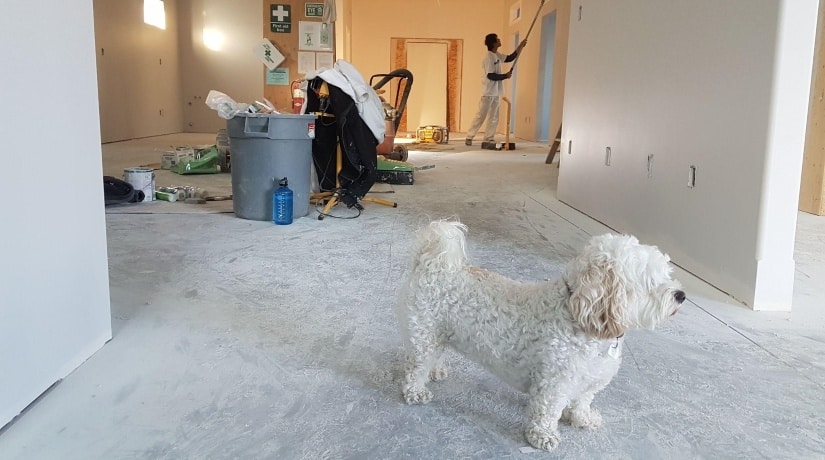Most pet owners consider their animal companions part of their family. They would do anything to protect them from anything that can compromise their safety or their health.
Pets can be exposed to toxic chemicals or building materials like asbestos, which can make them sick or give them cancer. Studies have shown that even privately-owned pets can suffer from malignant mesothelioma and its stages.
So, how can you protect your pets from asbestos exposure? What are the symptoms of asbestos exposure in humans and animals? What can you do about asbestos exposure?
Protect your pets from asbestos exposure by being aware of where any asbestos can be found in your home. Read on to understand what asbestos is and how it can also harm your pets.
This article will give you tips on protecting your pets so you can avoid or reduce their risks of asbestos exposure. You can use this handy checklist of things that you can do to identify, avoid and safely deal with asbestos in your home.
Pets like dogs could develop mesothelioma. Studies have shown that the latent period (the time between exposure and the onset of symptoms) for mesothelioma in a dog exposed to asbestos is less than eight years.
Asbestos Exposure: The Silent Threat to Humans and Pet Animals
Like people, your pet can also get unintentionally exposed to asbestos. This fibrous, toxic material doesn’t have an odor.
Since there are no immediate telltale signs of asbestos exposure, you can inhale the dust unknowingly. You can easily dismiss it as only harmless floating dust.
Unfortunately, asbestos exposure is a silent threat with no known immediate symptoms. It means your body won’t react now, but symptoms will appear later. In some cases, it may take five to ten years for people to get sick from exposure.
Remember that there are no safe levels for asbestos exposure. When you inhale the fibers, they irritate the lungs and interfere with immunocompetent cells, making you susceptible to tumors and cancer.
Unlike other medical conditions, mesothelioma is not unique to humans. Your family pets, like cats and dogs, are at risk of developing the threatening, asbestos-related cancer.
Malignant mesothelioma in both humans and animals is incurable. As with humans with malignant mesothelioma at the time of diagnosis, surgery is a rare option for pets. So, it’s essential that pet owners learn how to avoid exposing your pets to asbestos.
How You and Your Pet Can Avoid Asbestos Exposure
Dogs are playful and eager to explore. They love to go to places, especially inside your home. But it can also cause your pet to get exposed unintentionally to asbestos.
You can accidentally expose your pet to asbestos when you renovate your home or do minor repairs. If your home is not 100% free from asbestos, you can disturb the toxic fibers accidentally.
What You Can Do
You can avoid asbestos exposure by following the tips below.
1. Have your homes inspected for asbestos.
Find out if your home was built before the asbestos ban in 1989. If so, you should have your place inspected by a professional.
Asbestos became a popular construction material because of its many uses. People have used this material for fire protection and to reduce wear and tear in some materials.
You can also find asbestos in pipe linings, roofing, and inside walls. Other areas where asbestos may be present are listed below:
- Pipe insulation
- Building materials (siding, wallboard, spackling compounds, floor tile, ceiling tile)
- HVAC duct insulation
- Boiler insulation
- Cooling towers
- Electrical wiring insulation
2. Be careful with do-it-yourself renovations.
If you’re not sure whether your home is 100% free from asbestos, refrain from doing any DIY repairs. You can easily disturb materials that have asbestos, releasing it as dust that you and your pets can inhale. Have your home inspected first.
3. Be wary of construction or demolition sites.
Be wary of any demolition in your area because the building may have been built using materials with asbestos. The fibers can mix with the dust and settle around the area. Dogs and cats may lick or inhale contaminated dust from the pavement and get sick. Avoid these places when taking your dog out for a walk.
Also, be careful of going to homes under renovation unless you’re sure the house is free of asbestos. Remember that you can only be sure a house is safe when inspected.
What Happens When Pets Get Exposed to Asbestos?
The problem with asbestos is that it’s a toxic material, but you don’t get sick right after exposure. It takes time before any symptoms appear, and often it’s already too late. Asbestos exposure leads to asbestosis and mesothelioma.
According to the American Lung Association, asbestosis is the scarring of the lung tissue after Inhaling large amounts of its fibers or dust for a long time.
Mesothelioma is a rare and aggressive cancer caused by asbestos. This type of cancer affects both people and animals.
There are four types of mesothelioma:
- Pleural: Asbestos, when inhaled, travels into the lungs and attaches to the pleura, or the smooth lining covering the lungs. Inhalation is the most common way people get exposed to asbestos.
- Peritoneal: This type of mesothelioma affects the smooth lining that covers the abdomen. Asbestos exposure can also happen by ingestion.
- Pericardial: Asbestos can, on rare occasions, get lodged in the pericardium, the smooth lining that covers the heart.
- Testicular: This type of mesothelioma is one of the rarest types of cancer, where asbestos exposure causes cancerous growth at the testicles.
When symptoms start to show on your pet, contact your vet immediately. Don’t waste time, as these diseases are aggressive and life-threatening.
Signs of Mesothelioma in Pets

If you suspect your pet got exposed to asbestos, watch out for these early signs or symptoms. When you see these signs, bring them to the vet quickly to get a proper diagnosis and medical advice.
- Difficulty in breathing
- Labored breathing
- Shortness of breath and cough
- Loss of appetite
- Unexplained weight loss
- Lethargy
- Changes in behavior
Dogs Can Help Detect Mesothelioma
Dr. Thomas Quinn, a clinical professor at the Lake Erie College of Osteopathic Medicine, believes that dogs, especially beagles, could be trained to sniff out mesothelioma cases.
Dr. Quinn said that “What we’re doing here (with the beagles) is less expensive, more effective, more accurate and doesn’t expose a patient to radiation… Medical science today can cure even some of the worst cancers — if caught in the very early stages. Early detection is the major thing we need to do.”
A study on this subject showed a surprising ability for beagles to detect cases of this type of cancer accurately. They successfully detected blood serum with cancer amid other samples with 97.5% specificity and 96.7% sensitivity.
According to the study, a dog’s sense of smell is 10,000 times stronger than that of humans. Among canines, beagles are at the top of the olfactory list.
When you get a mesothelioma diagnosis, vets can use treatments to slow the spread of the disease. In some cases, when the disease is treated quickly, it can go into remission and not get serious.
What to Do When Asbestos Is Detected
When the inspection reveals areas in your home with asbestos, you need to call in the experts and have your home cleaned.
Here are some helpful tips on what to do when you think there’s asbestos in your home.
1. Don’t take any chances.
When you’re in doubt, always choose safety and don’t take any chances. If you think it’s asbestos, avoid it. Prevent others from going close to it, especially your pets. Remember that asbestos exposure is dangerous.
2. Get in touch with specialists and only hire professionals.
When you can’t get in touch with an asbestos removal team, you should take every precaution not to damage anything containing asbestos in your home. Aside from the risk of exposure, if you don’t hire specialists to handle asbestos, you may violate regulations imposed by the local authorities.
Never take chances; only hire trained professionals for inspection, repairs, testing, and removal. Always get the best group of professionals you can find.
3. Communicate with your agent.
When you suspect any asbestos risks in your home, always prioritize talking to your home inspector or real estate agent. Also, if you’re renting the place, you should inform the owner about the asbestos issue.
4. Contact regulatory agencies before demolishing anything.
When planning to demolish something, always contact your local regulatory agency first. Whether it’s a part of your home or a property you’ve just bought that you want to develop, contact the authorities first. Dogs may lick or eat things that have asbestos dust due to a recently demolished building.
5. Don’t disturb the source of asbestos.
Asbestos can break into microscopic shards like dust that you can quickly inhale.
When you suspect a part of your house has asbestos:
- Don’t sand, saw, scrape, drill, or disturb asbestos materials. If you see parts in your home that you think have asbestos, cordon it off and warn other people in your home.
- Never sweep, or vacuum asbestos dust. You will only cause the dust to become airborne and increase the risk of you or your pet getting exposed to this material.
6. Don’t Collect Asbestos.
When you find anything similar to asbestos, don’t store it. Asbestos dust is so toxic that once inside your body, it will react with your cells and cause DNA damage, resulting in tumors and cancers.
7. Always rely on professionals for disposal.
Only hire professionals when removing asbestos. Don’t rely on friends and family with no experience. You can find many services in your area that provide asbestos removal and disposal.
8. Never attempt to handle asbestos if not properly trained.
Handling asbestos is not a DIY project. Any mishandling can cause severe health issues for you, your loved ones, and your pets. Dust can spread everywhere in your home. It can get worse if you have centralized air conditioning. Remember to handle toxic materials with care.
9. Block off some areas in your home.
There are instances where you need to block off areas in your home to prevent your pets from wandering off to areas contaminated with asbestos.
When you need to block off areas in your home:
- Place fences to prevent entry
- Barricade the area
- Close the doors in contaminated rooms

10. Always ensure your pets are safe from exposure.
Your furry companions don’t know the dangers of asbestos or how to protect themselves from exposure. They rely on you and your care to safeguard them from getting sick.
Keep them away from places you think are asbestos-risk areas. Avoid going through demolition areas or places under construction and renovation, and always keep your home clean.
What Vets Can Do
Veterinarians use these medical procedures to treat pets with cancer.
-
Fluid draining: The disease can cause fluids to flood inside the body. The vet must remove these fluids, or it will worsen your pet’s disease.
Your vet will then drain the fluid and help your pet. However, this procedure only relieves your pet of this symptom.
-
Chemotherapy: Doctors usually recommend this for pets with cancer. The procedure uses chemicals that are injected directly into your pet. Before taking chemo, you must talk with your vet to know how your pet will react to the procedure.
Key Takeaway
Having a pet is both a joy and a responsibility. There are some benefits for humans, too.
Harold Herzog, a psychologist and professor at Western Carolina University and a pet-lover, said pet owners enjoy “…higher survival rates, fewer heart attacks, less loneliness, better blood pressure, better psychological well-being, lower rates of depression and stress levels, fewer doctor visits, increased self-esteem, better sleep, and more physical activity.”
So, take care of your pets because they also take good care of you.
